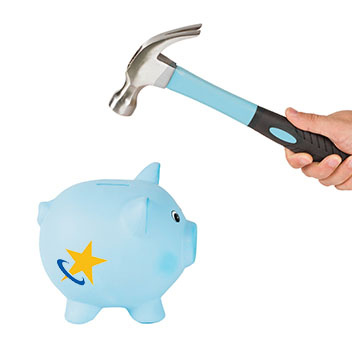Debt happens when you borrow money from a bank or credit company with an agreement to repay it later, often with additional money known as "interest." It’s a financial tool that allows you to pay for big expenses, like a house, car, or college education, even if you don’t have the cash upfront. However, not all debt works the same way.
Some debt is classified as "good debt." This type includes things like student loans for education, a mortgage for a home, or a business loan. Good debt can help improve your financial future by creating opportunities, bringing stability, and even building wealth over time.
On the other hand, there’s "bad debt." This is when you borrow for things that don’t increase in value or don’t help you build your financial future, like high-interest credit card debt for items you don’t really need.
Understanding the difference between good debt and bad debt is key to keeping your finances on track. When you know how to borrow wisely, you can make smarter choices, protect your credit score, and build a strong foundation for achieving your goals in life.
What Is Good Debt
Good debt is when you borrow money for something that has the potential to increase your wealth or income over time. Think of it as an investment in your future. While you may owe money, the goal is for this debt to eventually pay off by improving your financial situation.
Key Characteristics of Good Debt
Good debt usually comes with benefits that outweigh the costs. It’s often linked to things that offer a return on investment—essentially, it helps grow your money or provide long-term value. These types of debt are typically tied to education, income growth, or the value of assets like real estate.
Examples of Good Debt
- Student Loans: If education leads to a higher-paying career, your student loans could be considered good debt. Investing in skills and knowledge can be a steppingstone to greater financial independence.
- Mortgages: Buying a home with a mortgage can be good debt because a house can appreciate in value over time. Plus, every payment you make builds equity in your property.
- Small Business Loans: If you borrow to start or grow a business that becomes profitable, this can be another smart use of debt. A successful business can help increase your income and overall financial security.
The important thing with good debt is to be strategic—think about how it can help you in the long run. Borrow only what you need and make sure the return is worth the cost.
What Is Bad Debt
Bad debt is borrowing money for things that don’t help you build wealth or improve your financial situation in the long run. Unlike good debt, bad debt usually doesn’t lead to income growth or an increase in value.
Key Characteristics of Bad Debt:
High-Interest Rates: Bad debt often comes with steep interest rates, meaning you end up paying much more than what you borrowed.
Little-to-No Long-Term Benefit: The items or experiences you borrow for usually lose value quickly or don’t provide financial returns.
Examples of Bad Debt:
- Credit Card Debt for Non-Essential Purchases: Buying luxury items, vacations, or other "wants" on credit, rather than saving up for them, can lead to a cycle of high-interest debt.
- Payday Loans: These loans may seem like a quick fix, but they come with sky-high fees and interest rates that can trap you in debt.
- Auto Loans for Expensive Cars: Borrowing for a car that’s beyond your needs can be risky, especially since vehicles lose value rapidly as soon as you drive them off the lot.
The key to avoiding bad debt is to focus on borrowing for things that improve your financial future—and to think hard before taking on debt that doesn’t give you any long-term value.
Why the Difference Matters for Credit and Borrowing
Understanding the difference between good debt and bad debt is important because how you borrow and manage debt directly affects your financial health and creditworthiness. Not all debt is created equal, and lenders take a close look at your credit habits when deciding whether to approve loans or offer favorable interest rates.
Good Debt's Positive Impact on Credit
Good debt, when used wisely, may help strengthen your credit profile. For example, taking on installment loans like a mortgage or a student loan improves your credit mix by adding variety to your types of credit. This shows lenders that you can handle different forms of borrowing responsibly. Making payments on time builds a solid credit history, which is one of the most important factors in maintaining a strong credit score. If managed carefully, good debt can open doors to better borrowing options in the future.
Bad Debt's Negative Impact on Credit
Bad debt, on the other hand, has the opposite effect. High balances on credit cards can increase your credit utilization rate, which is a key factor in calculating your credit score. When utilization climbs above 30%, it may signal to lenders that you’re overextended financially.
Worse, missed or late payments on high-interest loans—like payday loans or credit card debt—can quickly drag down your credit score. This creates challenges for future borrowing, as lenders may view you as a risky borrower.
By focusing on avoiding bad debt and responsibly managing good debt, you’ll set yourself up for a more secure financial future and maintain strong borrowing power.
Financial Growth vs. Financial Strain
When it comes to debt, the way you use it can either support your financial goals or create significant challenges. Understanding the difference between good debt and bad debt is key to making decisions that help you grow financially.
Good Debt and Financial Growth
Good debt is an investment in your future. For instance, taking out student loans for a degree can increase your earning potential over time, helping you land higher-paying jobs. Similarly, a mortgage allows you to own a home, which can build equity as its value increases. These types of debt are often considered “good” because they contribute to long-term financial stability.
By handling good debt responsibly—like making payments on time and keeping balances manageable—you can also strengthen your credit profile. A strong credit score opens the door to future borrowing at lower interest rates, saving you money and providing financial flexibility when you need it.
Bad Debt and Financial Strain
Bad debt, however, can cause financial stress and strain. High-interest debts, like credit card balances or payday loans, can pile up quickly if you’re not careful. Accumulating too much of this kind of debt can lead to a vicious cycle—borrowing more to repay what you already owe. This cycle makes it harder to achieve long-term goals, such as saving for retirement or making investments that grow your wealth.
Bad debt often creates obstacles for building savings. If most of your income is used to pay off high-interest debt, there’s less money available for growing an emergency fund or contributing to a 401(k) or other investment accounts. Over time, these missed opportunities can hold you back from reaching a stable and secure financial future.
By focusing on taking on debt that works for you—like a student loan, mortgage, or small business loan—and avoiding high-interest debt traps, you’ll put yourself on the path to building wealth and achieving your financial dreams.
Tips for Managing Debt Wisely
Managing debt wisely is all about staying in control and making smart financial choices. Start by prioritizing paying off high-interest debt, like credit cards and payday loans. These types of debt grow quickly due to high rates, so tackling them first helps prevent unnecessary costs. When borrowing, focus only on what you truly need, not on wants. Before taking on any new debt, think about the long-term benefits—will it improve your opportunities, or is it just adding more financial strain?
Another key step is building an emergency fund. Having savings set aside means you won’t have to rely on expensive credit when unexpected expenses come up, like car repairs or medical bills. You should also aim to keep your credit utilization ratio below 30%. This means using only a small portion of your available credit, which helps maintain your credit score.
It’s important to always make payments on time. Late payments not only come with fees but can also hurt your credit score, making it harder to borrow in the future. By following these tips, you’ll be on the right track to managing your debt and achieving your financial goals.
Understanding the difference between good debt and bad debt is one of the most important steps you can take toward managing your finances effectively. Good debt, like student loans or a mortgage, is money you borrow to invest in your future. These types of debt often come with lower interest rates and can help you build wealth over time. For example, paying for schooling can lead to better job opportunities, while owning a home can increase in value and provide equity.
Bad debt usually comes with high-interest rates or is used to buy things that don’t add long-term value, like expensive gadgets, luxury items, or vacations. Bad debt can drain your finances quickly and make it harder to save for more important goals. That’s why it’s so important to think carefully before taking on any debt. Ask yourself if borrowing will help you achieve something meaningful, like getting an education, or if it’s just an expense that will weigh you down.
By recognizing the difference and focusing on good debt, you’ll be making smarter financial decisions that support your long-term goals. Always take time to evaluate your choices and create a plan that helps you stay in control of your finances. When you choose wisely, you set yourself up for a brighter and more stable financial future.







